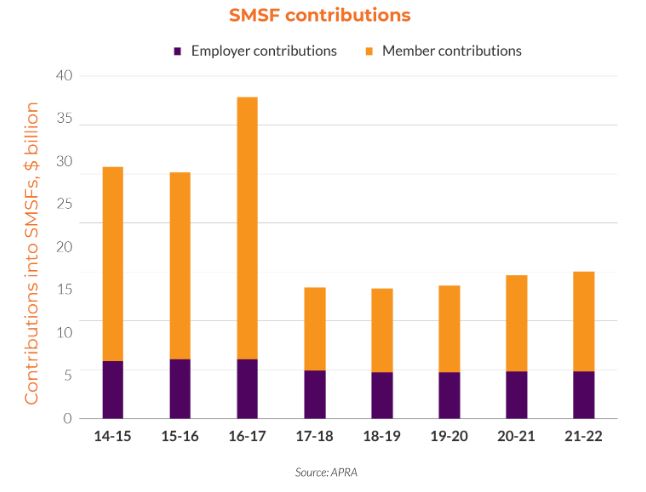The decline in contributions comes as the Australian Investment Exchange anticipates the establishment of new SMSFs to dwindle 18.24% in 2022-23.
Key points
- SMSF voluntary contributions have fallen from $38 billion in 2017 to $15 billion in 2022 - a decline of $23 billion.
- Aussies are transferring more money out of SMSFs, with the value of transfers doubling since 2017.
- Rainmaker Information detail SMSF funds under management have grown 5.8% p.a. since 2017, slower than the remainder of the superannuation sector at 6.6% p.a.
Rainmaker Information revealed prior to the introduction of the Transfer Balance Cap for SMSFs in 2017, SMSF member contributions exceeded $38 billion - two and a half times more than the current contribution amount.
The Transfer Balance Cap allows SMSF members to transfer up to $1.6 million into a retirement phase account in order to take advantage of tax breaks.
Importantly, amounts contributed outside of the $1.6 million are taxed at a rate of 15%.

Rainmaker Information Executive Director of Research and Compliance Alex Dunnin noted the introduction of the Transfer Balance Cap (TBC) profoundly changed the nature of the SMSF superannuation segment.
“It took the segment two years to regain composure after the 2017 tax shock and start growing again,” Mr Dunnin said.
Mr Dunnin said of greater intrigue for the SMSF sector is that since 2017, transfers out of SMSFs have almost doubled from $5 billion to $10 billion per annum in 2022.
This comes as Rainmaker Information revealed self-managed funds under management have grown 5.8% p.a. since 2017, markedly slower than the remainder of the superannuation sector at 6.6% p.a.
“SMSF members no longer seem to see their funds as the place to put their member contributions, but they clearly still see them as a very good place to store vast amounts of family-owned superannuation wealth,” Mr Dunnin said.
Speaking previously to Savings.com.au, WLTH CEO and Co-Founder Brodie Haupt detailed while a 15% decline in the growth rate of new SMSFs is forecast, WLTH remains confident SMSFs will continue to be a popular option for Australians who want more say over where and how their retirement savings are invested.
“Australians understand the importance of having a retirement fund they can control, especially during turbulent times,” Mr Haupt said.
“On top of this, it [self-managed super] presents a number of attractive tax benefits that help our customers shape their wealth-building journey.”
The news comes as the government announced a doubling of the tax rate to super balances above $3 million, while capital gains tax on unrealised gains has also been floated.
"SMSF voluntary contributions fall $23 billion over five years" was originally published on Savings.com.au and was republished with permission.
